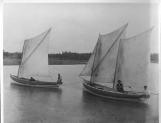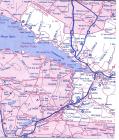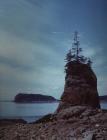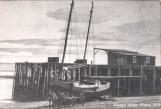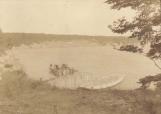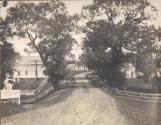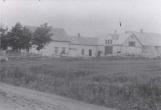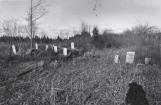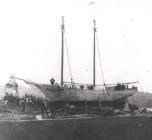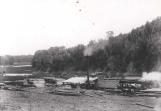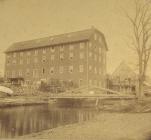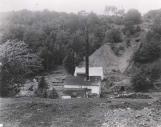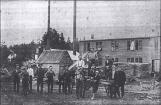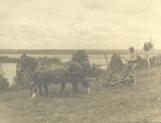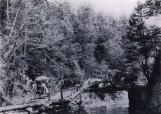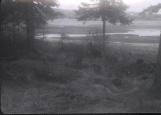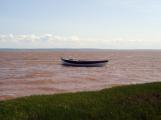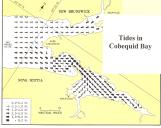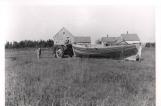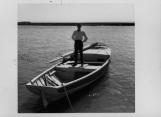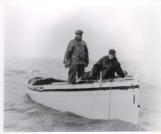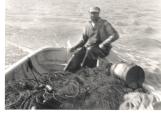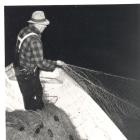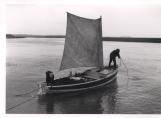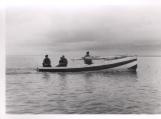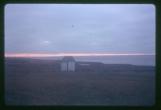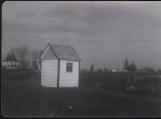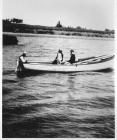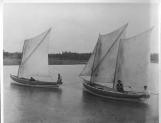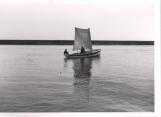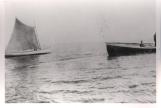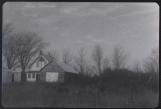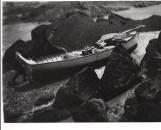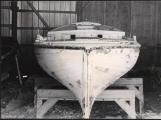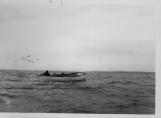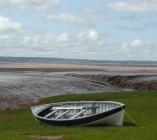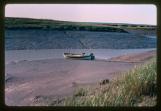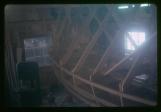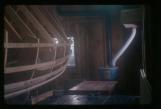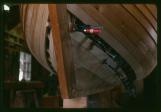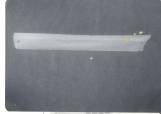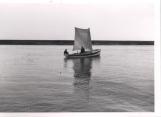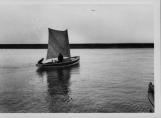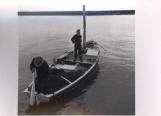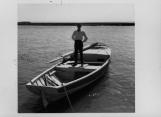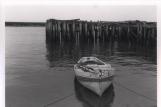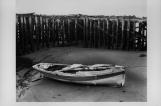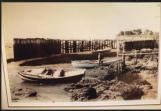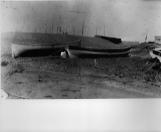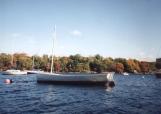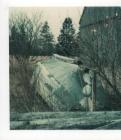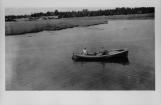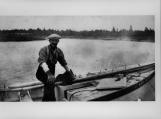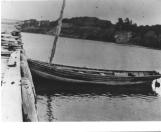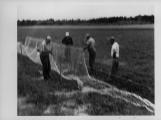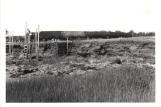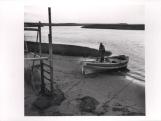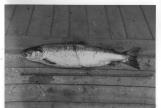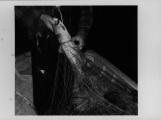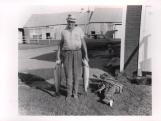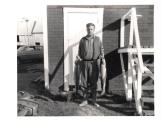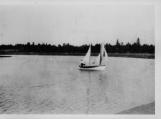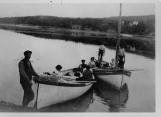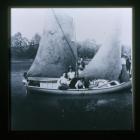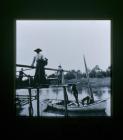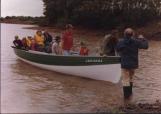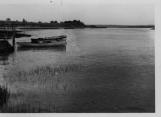

Colchester Historical Museum and Archives
Truro, Nova Scotia
4
Fishing has provided sustenance for maritime families since time immemorial. This Community Memories exhibit gives an account of the fishery (now gone) in Cobequid Bay from 1840-1994.5
Cobequid Bay lies at the upper reaches of the Bay of Fundy, Nova Scotia, Canada. The goephysical configurations causes the worlds highest tides here. Tides of fifty feet are not uncommon. As the bay empties twice every twenty-four hours, miles of sea floor are exposed.7
As the tide receded the schooner was left "high and dry" on the mud flats at Five Islands. This is a typical scene at low tide.9
A typical Cobequid Bay vista at Five Islands.11
As in all maritime communities during this period, the primary mode of transportation was by water. All communities on or near the water were serviced by wharves. Cobequid Bay's wharves were indispensable to every industry on its shores.13
Black Rock wharf where passengers are waiting to be loaded on the ferry to Maitland. "Time and tide wait for no man" especially on Cobequid Bay. There is no waiting for an errant passenger as the tide might drop so quickly that a boat could not leave its mooring.15
At the time of this account, the country side was rural. Taken at the end of the nineteenth century, before paving, we see Great Village, Nova Scotia, Canada as a typical rural community. Most of these houses are still standing.17
Built in 1890 this church is in use today.19
The Marsh home is typical of farm houses of the nineteenth century in Nova Scotia, Canada.21
Many of these children came from fishing families who fished for shad.23
The main road running through Bass River, Nova Scotia, Canada remains much the same today.25
This is the final resting place of Greg Hall, his wife Jerusha, and their son Will. Will and Greg were the premier builders of the Cobequid Bay Shadboat.27
Ship building was in its heyday and the wooden vessel reigned supreme. Most communities on both shores of the bay had at least one ship yard where, over a long period, turned out hundreds of wooden boats and ships.30
A ship of note built in the area (shown in the last two slides) is the Lady Smith, built in 1902 in Economy, Nova Scotia, Canada.32
This picture of the lumber mill was taken in 1909.34
One of a series of chair factories which were lost by fire. Built in 1886.36
Londenderry was a bustling town due to its steel making industry.38
The year this picture was taken, 1870, 4085 barrels were made in the area.40
A mower and his team cutting hay overlooking Cobequid Bay.42
This plant was located at Silica Lake, Castle Reagh. A seven mile pole railway conveyed the fossil flour to the ships. The plant burned in 1905.44
Baryte mining and the previous five slides depict industries that provided employement for the area.48
Weir fishing of shad had provided fish for the local inhabitants since Acadian settlement. Native inhabitants had trapped shad in a similar fashion but it was with the introduction of the drift-net that shad fishing became a viable industry. The potential of the area attracted an American, Tristram Halliday, who is credited with introducing the drift-net. He set up a fishing camp on Taylor Cove on Economy Point. There is some controversy about his place of origin but it was finallly concluded that he was from Saint John, New Brunswick.52
Tristram Halliday fished as many as sixty boats, and it from these boats that the Cobequid Bay Shadboat evolved, with hull shape and rigging being very similar to the American boats. Fishermen who fished shad in the rivers thought this way of fishing was damaging the stocks and requested government intervention. Fishermen from the township of Falmouth objected to the use of drift nets, especially to outsiders from New Brunswick. After investigation Halliday was permitted to continue his fishery. The approximate time of his unwelcome arrival was 1840. The last series of slides show the wording of the petition, followed by three pages of petitioners signatures.54
Alosa Sapidissima-sapidissima meaning "most delicious." Having 1500 bones the Mi'kmaq aptly refer to the largest members of the herring family as being "porcupines turned inside out." The body of the shad has a very lustrous apperance and scales cover its body. The largest shad would measure twenty-four inches.56
Shad feed on tiny aquatic animals such as copepods and mysids. Turbidity of the bay's waters is suited to its feeding needs, which are very light specific. At some point in its life cycle every non-spawning shad on the east coast of North America comes to the upper Bay of Fundy.58
Guided by the currents they start to arrive in mid June and continue to arrive until mid-October. At the time of Haliday's arrival the bay teemed with shad during the summer months. Local fishermen soon adopted Haliday's method of fishing and by 1870 there were nintey boats fishing forty miles of net from Harrington River to Chiganois River. At night, it is said that these nintey boats, each with its light, gave the apperance of a floating village.60
Shad were cleaned, split and salted in barrels and shipped to New England by boat. In 1860 there were 3495 barrels of salted shad, of two hundred pounds each, shipped from the area. Seventy-six exporters were noted in the 1861 census. The need for barrels resulted in the spin-off industry of coopering. This building in Portapique belonged to one merchant who handled salt shad.62
Many people at this time were involved in agriculture. To supplement incomes, most men fished in what became known as the "shadboat."64
Fishing in the summer, was as much a part of farm life as was working in the woods in the winter. Usually, farm work was done during the day and fishing at night.66
A farm boy would catch all the sleep he could, as he drifted down the bay, because he had hayed that afternoon and would be expected to put in time in the hay field the next day. Russell Cooke was fifteen years old in this picture and was his father's helper. Many men fished alone but an extra hand made the work easier.68
This is another farmer-fisherman who was assisted by a young son.70
As the name "drift-net" implies, the boats drifted with the tides trailing their nets, (as much as one mile of nets).72
When the boat reached a spot suitable for fishing the nets were payed out over the stern. The thole pins held the nets while the boat drifted. Thole pins are hardwood dowels inserted in holes in the gunwhales.74
When the tide was at "high-water slack" the nets were hauled, the fish removed, and the nets payed out again. They then drifted in the reverse direction, returning to their moorings in time, so they would not be marooned on the flats.76
Boats could leave their moorings approximately one and a half hours before high tide and could return one and a half hour after high tide. This meant that fishermen were on the water for nearly twelve hours.78
Upon arrival at the fishing site, the sails were furled tightly around the masts and the masts unstepped. The masts were stored, with their sprits, along the gunwhales. This prevented the boat from rolling. In this picture one method of handling the unstepped mast is shown.80
At night, lighthouses along the shore gave fishermen their bearings. In the spring the lighthouses were lit for the season. Local knowledge informs us that the Burncoat light was the first to be lit each year. In 1912 the light was lit on March 22.82
This small lighthouse was built between 1890-1900 and was referred to as the "Outhouse lighthouse." Robert Smith Hennessy built the building on land he leased to the government along with a right-of-way. He was responsible for circulating a petition to gather support to have a lighthouse in that area. Supplies for the light were provided by the Federal Government and delivered to Bass River in the spring of each year. Depending on which party was in power, it was determined who was to be lightkeeper. Colour of the lights alternated along the shore-this light was red and could be seen for eight miles down the shore. The erosion along the shore made it necessary to move the building further inland every year or so.84
A kerosene lantern was hung on a pole and in the day time was kept in the building. Smith Hennessy, Highland Village, a local farmer/fisherman usually tended this lighthouse according to which political party was in power. The wage for maintaining the light was seven dollars a month.86
Smith Hennessy lived in Highland Village; his home still stands. His boat Lily was built by Ross Chisholm.88
The following points can be seen in this slide. The traditional rigging of a shad boat is that of a ketch with a longer foremast; the main mast being shorter. The sails are fastened permanently to the masts which are unstayed and sprit-rigged. The end of the sprit (a long pole) with its hook is hooked to the free end of the sail. The lower end of the sprit sits in a becket or snotter which is moved up and down the mast to add or remove tautness in the sail. The full rigging included a jib. The main mast is fastened to a boom while the foresail is loose- footed. There are three mast positions; in heavy weather the mainmast is moved to the foremost position and used alone. This makes for an extremely safe boat. The nets were payed out over the stern and when trailing were fastened to thole pins( pegs in the gunwhales). Every boat carried at least one set of oars in case of being becalmed. The boats also carried an anchor and a dipsy or lead line to take soundings.90
Shadboats all had a cuddy as shown in this slide of the Ocean Queen's stern. Various tools were stowed there.92
Each boat carried a lantern for obvious reasons. With so many boats on the water one needed to know the whereabouts of ones neighbours.94
Often fishing was done in close proximity to other boats.96
An important industry that resulted from the fishery was that of boat building. Some men engaged in the fishery, built their own boats. One such man was Will Ewing. After a stormy night on the bay, his wife tried to extract a promise that he would not fish in such conditions again, his reply was "Blast, Mellissa you have nothing to fear, for I built her myself."Although time has erased the knowledge of earlier builders of shadboats, we do know of two builders, Greg and Will Hall.
98
The Halls were recognized as the premier builders of shadboats. In the 1881 census Greg Hall was listed as "boat builder." Will Hall had gone to the States to work in a ship yard but returned to work with his father in 1919. In 1900, seven boats were built in this boat shop (in the forground.) This building still stands and as late 1972, still had much of its equipment. There is no record of the numbers of boats built by the Halls but their output was considerable. Some were transom-sterned, others were pinkies (sharp at both ends.) On some the topsides were lapped (clinker planked.) It is said that some of the earlier boats were totally of clinker construction; others were totally carvel. Every fisherman had his own reasons for choosing one of the variations. The following boats are some of their output.103
In the last four slides, Thermopylae was featured. Her owner Bernard Taylor purchased her from the Halls in 1926. She was unrigged with centerboard, rudder and tiller, oars and oarlocks, bow and stern sheets, small cuddy, painted inside and out. The cost was one hundred-fifty dollars. In the slide showing her fishing with Montrose one can see that her rigging was not traditional, having only one sail with a very long boom.109
When Alan Whidden's father decided to fish shad in 1923, he approached the Halls and brought home the boat shown in the last five slides. At twenty-one and a half feet long, Seagull was one of the smaller boats. She was copper fastened; most of the boats were fastened with galvanized nails.Mr. Whidden found the two-masted rig to be too much for her and dispensed with the smaller mainsall.
By this time the fishermen were beginning to install make-and-break engines and these and the cuddy cabins built into the boats eliminated the opportunity to make full sail.
Sail then became the auxiliary power and the era of the sailing shadboat was effectively over.
113
One of the remaining shad boats is the Ocean Queen, known as the "Big Pinky". She was built by the Halls in 1900. She was converted in the mid twenties to inboard motor. We note the extended stern added to accomodate the propellor. Note also the added cuddy and engine box. She is one of the longer boats built by Halls, being twenty-five feet long. The length of the boats could be said to be between twenty-one and twenty-five feet with beams of seven to eight feet. It was built for Fletcher Spencer, later fished by Nobel Spencer who gave it to Robert Cooper. It was suggested by Nobel Spencer's father that he "drag that old boat out and burn it." She is now in the permanent collection of The Mystic Seaport Marine Museam, Connecticutt. At the time of her retirement, four generations of the Spencer family had fished from her.115
Jerusha, is a faitful reproduction of the Ocean Queen with the exception of the top three planks which are lapstrake. The construction was followed meticulously using the same local materials as the Halls used. Birch was used for the keel, pine for the planking, hackmatack for floors, knees, stem and stern posts. The frames are white oak and the breast hooks are of apple. The frames were steamed in the steam box noted by the hot spot.120
The previous four slides show the construction of shadboats. Note the steam box used to steam the frames. Note also the attractive run of the planks. The first slide in this series show a completed Jerusha at low tide.122
Rarely were half models used in construction of shadboats. Other than this model owned by Lester Spencer, none have been recorded.131
Shamrock is the most important artifact of the shad fishery. When she was donated to the Maritime Museum of the Atlantic she had had little repair and was a good example of the Hall's craftmanship. Built in 1900 she fished until the mid seventies with the exception of the war years. She was built for Lorne Cooke. In the slide series of the previous eight slides she is shown at high and low tides. Harold and Russell Cooke are slipping lines, with the nets stowed in the stern, the rudder and tiller in place. In this picture we can see the oars and the black net marker. Two slides show the fishermen leaving their mooring headed for the fishing grounds. Note the Ocean Queen in the lower right hand corner.133
The latter two boats were built by Halls.135
Juanita was built by the Halls in the early 1900's for Norman Spencer. For many years, Juanita sat in the Hall's boat shop in a damaged condition. Charles Colville purchased and restored her. She is shown in the background of a previous slide when she was still being fished.137
It is thought that the Halls also built this boat belonging to Bloise Boyd.139
These three boats were Hall-built. The Montrose was built for Dave Collins, shown in the bow of the boat. The owner of the Bay Queen was Will Hall (standing in his boat) who was recognized as the best sailor on the bay. Sailing the Shamrock, Will once outsailed his father, Greg, much to his dad's chagrin.142
In a previous slide of Montrose under full sail she was painted white; in these two slides she has been painted dark green. Dave Collins along with Oz Taylor, Alden Knight and Homer Crowe had summer camps at Portapique during fishing season, which usually lasted four months.144
After Bayview was converted to inboard motor, this picture was taken. Note the added cuddy with opening to accomodate the mast which, with its sprit, is lying on the rail. Will Hall is her owner.146
Other builders contributed to the fleet but not to the extent of the Halls. Some are known, some are not. Here at the Walton wharf (on the south shore of the bay) is moored a boat belonging to John McLellan. Note the motor installed well aft.One boat in existence today is a boat built by Perc Densmore in the early forties. This is another Seagull and is in Aubrey Scott's boathouse in Noel.
148
When the photo was taken, this inlet moored seven boats. Erosion had destroyed much of the shoreline. The boathouse on the left was moved to the farm we see in the background and is used as a storage shed. Lily was so named because she was all white. She is twenty-one feet long. At the tiller is Putnam Hennessy, at the bow is Robert Hennessy, son Graham and wife Sadie.150
A boat of unknown origin is shown here.151
Bernard Taylor left and Stanley Cochrane with an unknown boat.1945
Highland Village, Nova Scotia, Canada
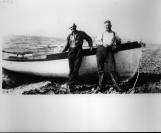
152
The builder of this boat is unknown, as is its name.154
Where ever boats were moored net horses were erected to dry nets between sailings. Originally in the eighteenth and nineteenth century, nets were made of linen and were often knit at home by the fishermen's wives. Later with the development of synthetic fibers, fishermen switched to nylon. Linen nets had to be dried and tanned regularly. The introduction of nylon nets lessened the work load considerably.Isabel Hennessy Horne remembers her mother and father kniting net in the winters. Her dad always referred to his nets as "bunches" and on May 22,1901, in his diary he spoke of oiling a new bunch of net.
156
Every spring, nets had to be inspected and repaired.158
As mentioned, net horses were a common sight wherever boats were moored. A ladder up the steep embankment provided access to the horses.160
From the net horses the nets were loaded into the stern of the boat which we see Harold Cooke doing. Note the floats on the nets to mark their position in the water and the larger black steel drum which is also used to mark their position. Oars are evident, as well as the mast on the rail of the boat. We can also see the mooring lines. Most boats were tied to three posts.162
A by-catch of Atlantic salmon was commonplace to the shad fishery.164
During the fifties as many as forty could be caught on one tide. These were always welcome, bringing a higher price. On a barrell one can see the scale where they were weighed.166
The method of removing a salmon from the gill-net would be the same as removing a shad.168
A previous slide showed a salmon that measured thirty-three inches. These two salmon measured that long at least.170
As mentioned a by-catch of salmon was part of shad fishing. These wonderful specimens are being displayed by Russell Cooke.172
After a week of hard work on land and water, many families enjoyed a Sunday sail or a race. The Montrose seems to be newly painted and is sporting a new suit of sails. Note the men in their white shirts, which would indicate it was likely Sunday.174
We aren't sure who the children are but the skipper is Dave Collins in the Montrose (now painted green) out for a Sunday sail.176
Dave Collins is standing in the bow of Montrose with his wife Etta Creelman directly behind him. In the boat in the forground we see Will Hall and his boat (probably the Bay Queen). Obviously this is a special event. Dave Collins at one time fished as a helper with Greg Hall.178
Vincent Faulkner's house still stands in Great Village. His neighbours are being treated to a Sunday sail.180
After a recreational sail we can see passengers disembarking via the net horses. This unnamed boat belonged to Vincent Faulkner.182
These neighbours are enjoying each other's company, no doubt discussing the merits of their boats. Seated from left to right are Alden Knight, Ted Taylor, who fished with Dave Collins, John Davison, Dave Collins and Alan Davison. The rudder bar indicates that the boat has been motorized.184
Jerusha has been used solely for recreation, having been used for fishing only once in preperation for this exhibit.186
By 1923 most of these shad boats had been motorized but kept sail as an auxiliary source of power. Cuddies and motor boxes were built. The motors were referred to fondly as one-lungers, having only one cylinder. With the damming of many rivers and polution in others on the North American eastern seaboard the numbers of shad declined around the beginning of the twentieth century. Numbers of fishing boats declined to about half the original number and continued to decline. Now the catches were moved to the traditional markets in fresh, rather than salted condition. Packed between layers of ice and grass much of the catch moved to New England on the Boston train.188
With the exception of the Ocean Queen and Shamrock, the shadboats of Cobequid Bay are gone. The last fishermen, Russel Cooke and Karl Spencer, ended their fishing careers in 1994 when the last shad license for Cobequid Bay was issued. Thus ended a way of life which had sustained many families for one hundred and fifty years.189
CreditsWithout the help of the people included in the list of credits, this exhibit would not have been possible.
Enid Cooper
The late Robert Cooper
The late Harold Cooke
The late Noble Spencer
Russell Cooke
George Cooke
Cyril Roberts
Emily Lane
Isobel Hennessy Horne
Logan Spencer
The late Alan Whidden
Alec Forbes
Jack Johnson
Dan Wallace
Joe Cooper
Dianne Joan Hartling
Robert Gibson
